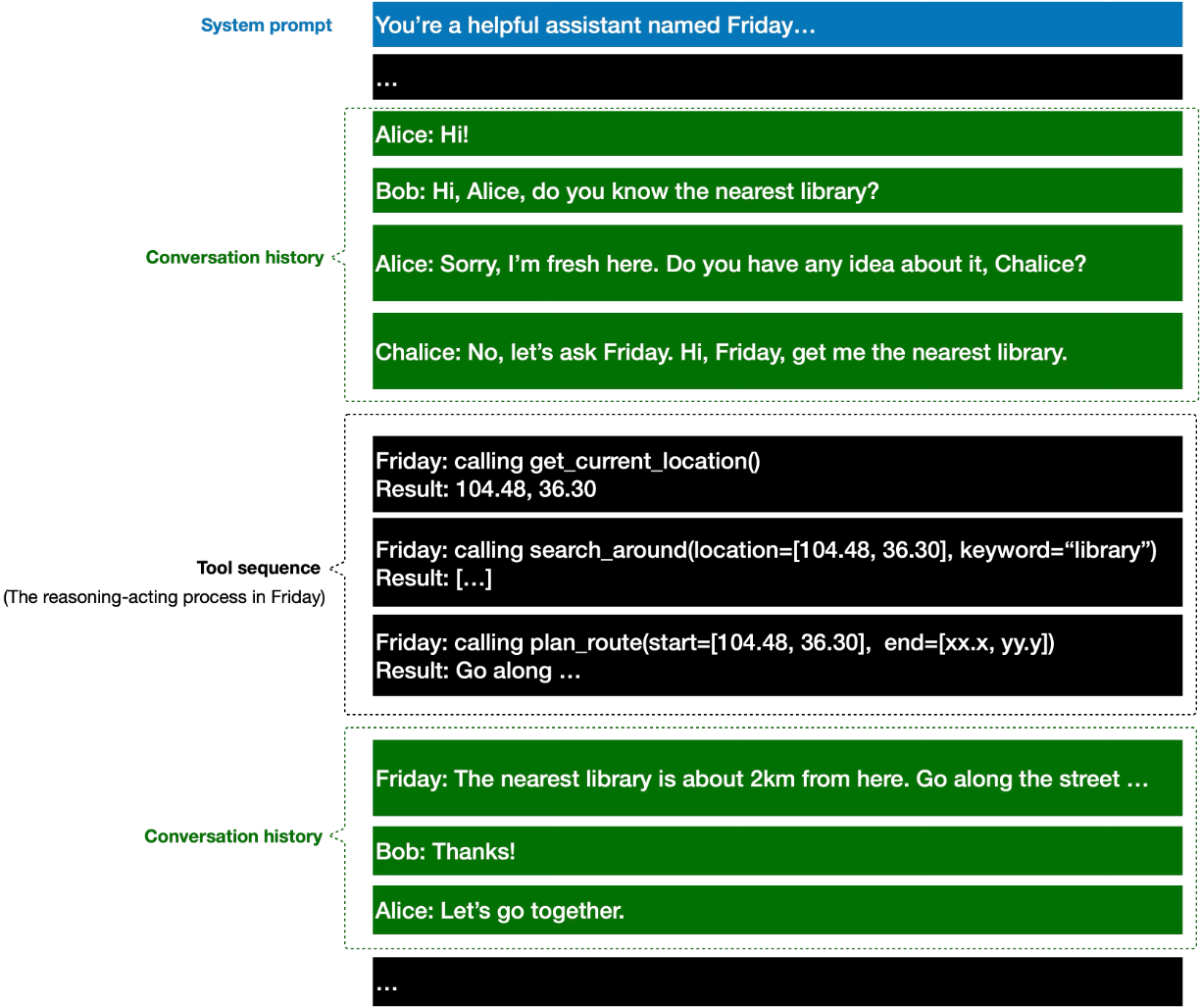备注
Go to the end to download the full example code.
提示词格式化¶
AgentScope 中的格式化器(formatter)模块负责
将 Msg 对象转换为不同 LLM API 要求的格式,
(可选)截断消息以适应 max_token 的限制,
(可选)执行提示工程,例如对长对话进行总结。
后两个功能是可选的,开发者也可以选择在记忆(memory)或智能体(agent)层面进行处理和实现。
在 AgentScope 中,有两种类型的格式化器:"ChatFormatter" 和 "MultiAgentFormatter",它们根据输入消息中的“身份实体”进行区分。
ChatFormatter:专为标准的用户-助手场景(聊天机器人)设计,使用
role字段来识别用户和助手。MultiAgentFormatter:专为多智能体场景设计,使用
name字段来识别不同的实体,在格式化的过程中会将多智能体的对话历史合并为单个消息。
AgentScope 内置的格式化器如下所列
API 提供商 |
用户-助手场景 |
多智能体场景 |
|---|---|---|
OpenAI |
|
|
Anthropic |
|
|
DashScope |
|
|
Gemini |
|
|
Ollama |
|
|
DeedSeek |
|
|
vLLM |
|
|
小技巧
OpenAI API 支持 name 字段,因此 OpenAIFormatter 也可以用于多智能体场景。也可以使用 OpenAIMultiAgentFormatter 代替,它会将对话历史合并为单个用户消息。
此外,内置格式化器对于不同的消息块(message blocks)的支持情况如下表所示:
格式化器 |
tool_use/result |
image |
audio |
video |
thinking |
|---|---|---|---|---|---|
|
✅ |
✅ |
✅ |
❌ |
|
|
✅ |
✅ |
✅ |
❌ |
|
|
✅ |
✅ |
✅ |
❌ |
|
|
✅ |
✅ |
❌ |
❌ |
✅ |
|
✅ |
✅ |
❌ |
❌ |
✅ |
|
✅ |
✅ |
✅ |
✅ |
|
|
✅ |
✅ |
✅ |
✅ |
|
|
✅ |
✅ |
❌ |
❌ |
|
|
✅ |
✅ |
❌ |
❌ |
|
|
✅ |
❌ |
❌ |
❌ |
|
|
✅ |
❌ |
❌ |
❌ |
备注
如 官方文档 所述,只有 Anthropic 建议在输入的提示词中保留推理的部分(thinking blocks)。对于其它格式化器,我们忽略输入消息中包含的 ThinkingBlock。
面向 ReAct 的格式化¶
内置的 formatter 均面向 ReAct 智能体进行设计,其中输入消息由交替的 对话历史 和 工具调用序列 组成。
在用户-助手场景中,对话历史是用户和助手的消息,我们直接将它们转换为所期望的格式。 然而,在多智能体场景中,对话历史是来自不同智能体的消息列表,如下所示:

多智能体消息示例¶
因此,我们必须将对话历史合并为带有标签 "<history>" 和 "</history>" 的单个用户消息。 以 DashScope 为例,格式化后的消息将如下所示:
from agentscope.token import HuggingFaceTokenCounter
from agentscope.formatter import DashScopeMultiAgentFormatter
from agentscope.message import Msg, ToolResultBlock, ToolUseBlock, TextBlock
import asyncio, json
input_msgs = [
# 系统提示
Msg("system", "你是一个名为 Friday 的有用助手", "system"),
# 对话历史
Msg("Bob", "你好,Alice,你知道最近的图书馆在哪里吗?", "assistant"),
Msg(
"Alice",
"抱歉,我不知道。Charlie,你有什么想法吗?",
"assistant",
),
Msg(
"Charlie",
"没有,我们问问 Friday 吧。Friday,帮我找到最近的图书馆。",
"assistant",
),
# 工具序列
Msg(
"Friday",
[
ToolUseBlock(
type="tool_use",
name="get_current_location",
id="1",
input={},
),
],
"assistant",
),
Msg(
"system",
[
ToolResultBlock(
type="tool_result",
name="get_current_location",
id="1",
output=[TextBlock(type="text", text="104.48, 36.30")],
),
],
"system",
),
Msg(
"Friday",
[
ToolUseBlock(
type="tool_use",
name="search_around",
id="2",
input={"location": [104.48, 36.30], "keyword": "library"},
),
],
"assistant",
),
Msg(
"system",
[
ToolResultBlock(
type="tool_result",
name="search_around",
id="2",
output=[TextBlock(type="text", text="[...]")],
),
],
"system",
),
# 对话历史继续
Msg("Friday", "最近的图书馆是...", "assistant"),
Msg("Bob", "谢谢,Friday!", "user"),
Msg("Alice", "我们一起去吧。", "user"),
]
async def run_formatter_example() -> list[dict]:
"""多智能体消息格式化示例。"""
formatter = DashScopeMultiAgentFormatter()
formatted_message = await formatter.format(input_msgs)
print("格式化后的消息:")
print(json.dumps(formatted_message, indent=4, ensure_ascii=False))
return formatted_message
formatted_message = asyncio.run(run_formatter_example())
格式化后的消息:
[
{
"role": "system",
"content": "你是一个名为 Friday 的有用助手"
},
{
"role": "user",
"content": "# Conversation History\nThe content between <history></history> tags contains your conversation history\n<history>\nBob: 你好,Alice,你知道最近的图书馆在哪里吗?\nAlice: 抱歉,我不知道。Charlie,你有什么想法吗?\nCharlie: 没有,我们问问 Friday 吧。Friday,帮我找到最近的图书馆。\n</history>"
},
{
"role": "assistant",
"content": [
{
"text": null
}
],
"tool_calls": [
{
"id": "1",
"type": "function",
"function": {
"name": "get_current_location",
"arguments": "{}"
}
}
]
},
{
"role": "tool",
"tool_call_id": "1",
"content": "104.48, 36.30",
"name": "get_current_location"
},
{
"role": "assistant",
"content": [
{
"text": null
}
],
"tool_calls": [
{
"id": "2",
"type": "function",
"function": {
"name": "search_around",
"arguments": "{\"location\": [104.48, 36.3], \"keyword\": \"library\"}"
}
}
]
},
{
"role": "tool",
"tool_call_id": "2",
"content": "[...]",
"name": "search_around"
},
{
"role": "user",
"content": "<history>\nFriday: 最近的图书馆是...\nBob: 谢谢,Friday!\nAlice: 我们一起去吧。\n</history>"
}
]
具体来说,对话历史被格式化为:
print("第一段对话历史:")
print(formatted_message[1]["content"])
print("\n第二段对话历史:")
print(formatted_message[-1]["content"])
第一段对话历史:
# Conversation History
The content between <history></history> tags contains your conversation history
<history>
Bob: 你好,Alice,你知道最近的图书馆在哪里吗?
Alice: 抱歉,我不知道。Charlie,你有什么想法吗?
Charlie: 没有,我们问问 Friday 吧。Friday,帮我找到最近的图书馆。
</history>
第二段对话历史:
<history>
Friday: 最近的图书馆是...
Bob: 谢谢,Friday!
Alice: 我们一起去吧。
</history>
基于截断的格式化¶
通过 AgentScope 中的 token 模块,内置格式化器支持通过 **删除最旧的消息**(除了系统提示消息)在 token 超过限制时截断输入消息。
以 OpenAIFormatter 为例,我们首先计算输入消息的总 token 数。
async def run_token_counter() -> int:
"""计算输入消息的 token 数量。"""
# 我们使用 huggingface token 计数器用于 dashscope 模型。
token_counter = HuggingFaceTokenCounter(
"Qwen/Qwen2.5-VL-3B-Instruct",
use_mirror=False,
)
return await token_counter.count(formatted_message)
n_tokens = asyncio.run(run_token_counter())
print("格式化消息中的 token 数量为:", n_tokens)
None of PyTorch, TensorFlow >= 2.0, or Flax have been found. Models won't be available and only tokenizers, configuration and file/data utilities can be used.
格式化消息中的 token 数量为: 165
然后我们将最大 token 限制设置为比总 token 数少 20 个,并运行格式化器。
async def run_truncated_formatter() -> None:
"""带截断的消息格式化示例。"""
token_counter = HuggingFaceTokenCounter(
pretrained_model_name_or_path="Qwen/Qwen2.5-VL-3B-Instruct",
use_mirror=False,
)
formatter = DashScopeMultiAgentFormatter(
token_counter=token_counter,
max_tokens=n_tokens - 20,
)
truncated_formatted_message = await formatter.format(input_msgs)
n_truncated_tokens = await token_counter.count(truncated_formatted_message)
print("截断后的 token 数量:", n_truncated_tokens)
print("\n截断后的对话历史:")
print(truncated_formatted_message[1]["content"])
asyncio.run(run_truncated_formatter())
截断后的 token 数量: 136
截断后的对话历史:
# Conversation History
The content between <history></history> tags contains your conversation history
<history>
Charlie: 没有,我们问问 Friday 吧。Friday,帮我找到最近的图书馆。
</history>
我们可以看到来自 Bob 和 Alice 的前两条消息被删除以适应 max_tokens 的限制。
自定义格式化器¶
AgentScope 提供了两个基类 FormatterBase 和其子类 TruncatedFormatterBase。
其中 TruncatedFormatterBase 类提供了 FIFO(First In First Out)截断策略,所有内置格式化器都继承自它。
类 |
抽象方法 |
描述 |
|---|---|---|
|
|
将输入的 |
|
|
格式化智能体消息,在多智能体场景中可能包含多个身份 |
|
将工具使用和结果序列格式化为所期望的格式 |
|
|
将输入的 |
小技巧
TruncatedFormatterBase 中的 _format 将输入消息分组为智能体消息和工具序列,然后分别通过调用 _format_agent_message 和 _format_tool_sequence 来格式化它们。开发者可以重写两个函数来实现自己的格式化策略。
小技巧
可选地,开发者可以重写 TruncatedFormatterBase 中的 _truncate 方法来实现自己的截断策略。
进一步阅读¶
Total running time of the script: (0 minutes 2.678 seconds)